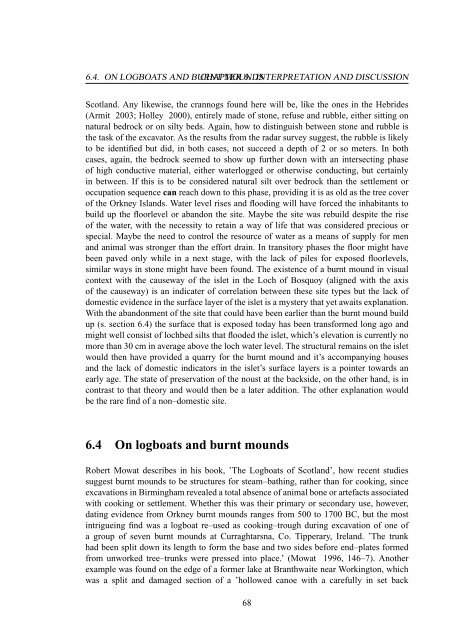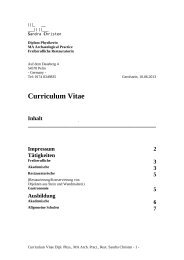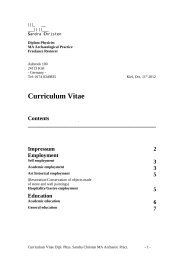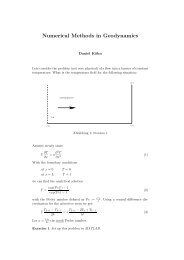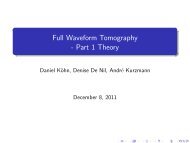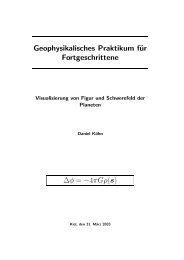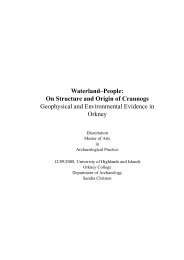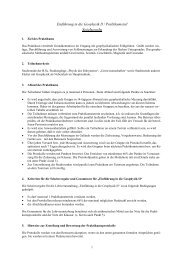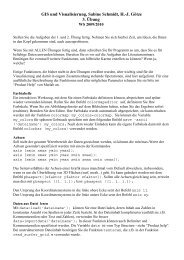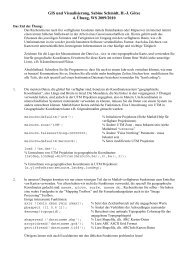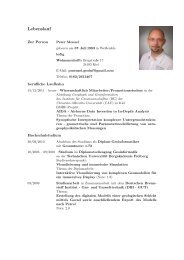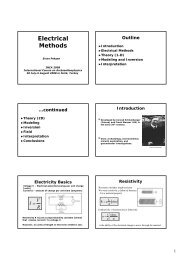Waterland–People: On Structure and Origin of Crannogs ...
Waterland–People: On Structure and Origin of Crannogs ...
Waterland–People: On Structure and Origin of Crannogs ...
Create successful ePaper yourself
Turn your PDF publications into a flip-book with our unique Google optimized e-Paper software.
6.4. ON LOGBOATS AND BURNT CHAPTER MOUNDS 6. INTERPRETATION AND DISCUSSION<br />
Scotl<strong>and</strong>. Any likewise, the crannogs found here will be, like the ones in the Hebrides<br />
(Armit 2003; Holley 2000), entirely made <strong>of</strong> stone, refuse <strong>and</strong> rubble, either sitting on<br />
natural bedrock or on silty beds. Again, how to distinguish between stone <strong>and</strong> rubble is<br />
the task <strong>of</strong> the excavator. As the results from the radar survey suggest, the rubble is likely<br />
to be identified but did, in both cases, not succeed a depth <strong>of</strong> 2 or so meters. In both<br />
cases, again, the bedrock seemed to show up further down with an intersecting phase<br />
<strong>of</strong> high conductive material, either waterlogged or otherwise conducting, but certainly<br />
in between. If this is to be considered natural silt over bedrock than the settlement or<br />
occupation sequence can reach down to this phase, providing it is as old as the tree cover<br />
<strong>of</strong> the Orkney Isl<strong>and</strong>s. Water level rises <strong>and</strong> flooding will have forced the inhabitants to<br />
build up the floorlevel or ab<strong>and</strong>on the site. Maybe the site was rebuild despite the rise<br />
<strong>of</strong> the water, with the necessity to retain a way <strong>of</strong> life that was considered precious or<br />
special. Maybe the need to control the resource <strong>of</strong> water as a means <strong>of</strong> supply for men<br />
<strong>and</strong> animal was stronger than the effort drain. In transitory phases the floor might have<br />
been paved only while in a next stage, with the lack <strong>of</strong> piles for exposed floorlevels,<br />
similar ways in stone might have been found. The existence <strong>of</strong> a burnt mound in visual<br />
context with the causeway <strong>of</strong> the islet in the Loch <strong>of</strong> Bosquoy (aligned with the axis<br />
<strong>of</strong> the causeway) is an indicater <strong>of</strong> correlation between these site types but the lack <strong>of</strong><br />
domestic evidence in the surface layer <strong>of</strong> the islet is a mystery that yet awaits explanation.<br />
With the ab<strong>and</strong>onment <strong>of</strong> the site that could have been earlier than the burnt mound build<br />
up (s. section 6.4) the surface that is exposed today has been transformed long ago <strong>and</strong><br />
might well consist <strong>of</strong> lochbed silts that flooded the islet, which’s elevation is currently no<br />
more than 30 cm in average above the loch water level. The structural remains on the islet<br />
would then have provided a quarry for the burnt mound <strong>and</strong> it’s accompanying houses<br />
<strong>and</strong> the lack <strong>of</strong> domestic indicators in the islet’s surface layers is a pointer towards an<br />
early age. The state <strong>of</strong> preservation <strong>of</strong> the noust at the backside, on the other h<strong>and</strong>, is in<br />
contrast to that theory <strong>and</strong> would then be a later addition. The other explanation would<br />
be the rare find <strong>of</strong> a non–domestic site.<br />
6.4 <strong>On</strong> logboats <strong>and</strong> burnt mounds<br />
Robert Mowat describes in his book, ’The Logboats <strong>of</strong> Scotl<strong>and</strong>’, how recent studies<br />
suggest burnt mounds to be structures for steam–bathing, rather than for cooking, since<br />
excavations in Birmingham revealed a total absence <strong>of</strong> animal bone or artefacts associated<br />
with cooking or settlement. Whether this was their primary or secondary use, however,<br />
dating evidence from Orkney burnt mounds ranges from 500 to 1700 BC, but the most<br />
intrigueing find was a logboat re–used as cooking–trough during excavation <strong>of</strong> one <strong>of</strong><br />
a group <strong>of</strong> seven burnt mounds at Curraghtarsna, Co. Tipperary, Irel<strong>and</strong>. ’The trunk<br />
had been split down its length to form the base <strong>and</strong> two sides before end–plates formed<br />
from unworked tree–trunks were pressed into place.’ (Mowat 1996, 146–7). Another<br />
example was found on the edge <strong>of</strong> a former lake at Branthwaite near Workington, which<br />
was a split <strong>and</strong> damaged section <strong>of</strong> a ’hollowed canoe with a carefully in set back<br />
68


